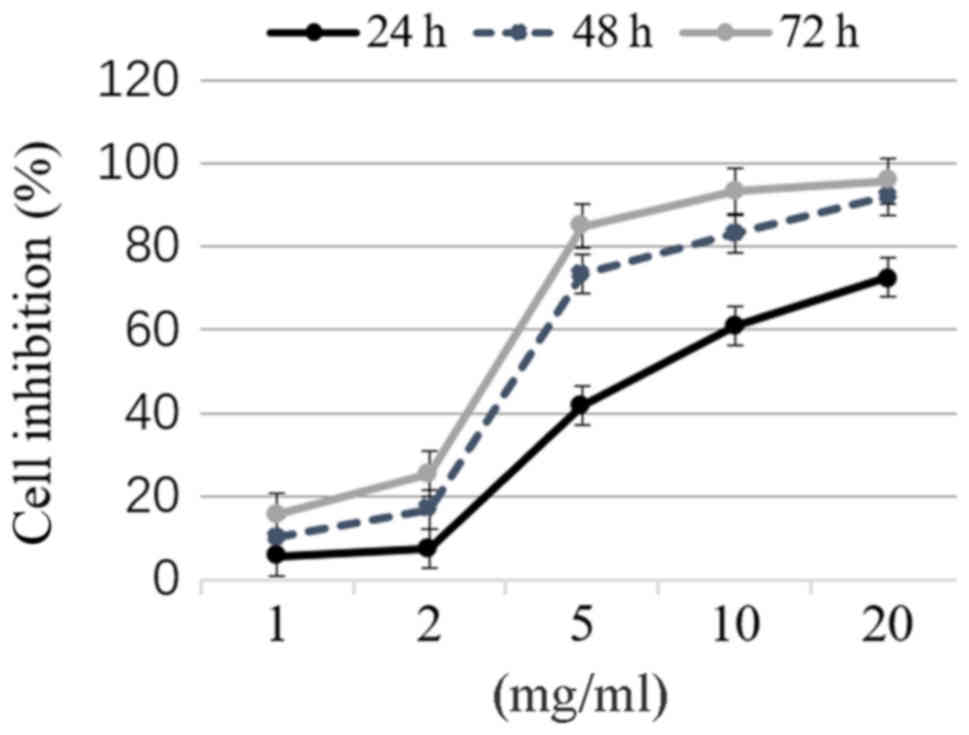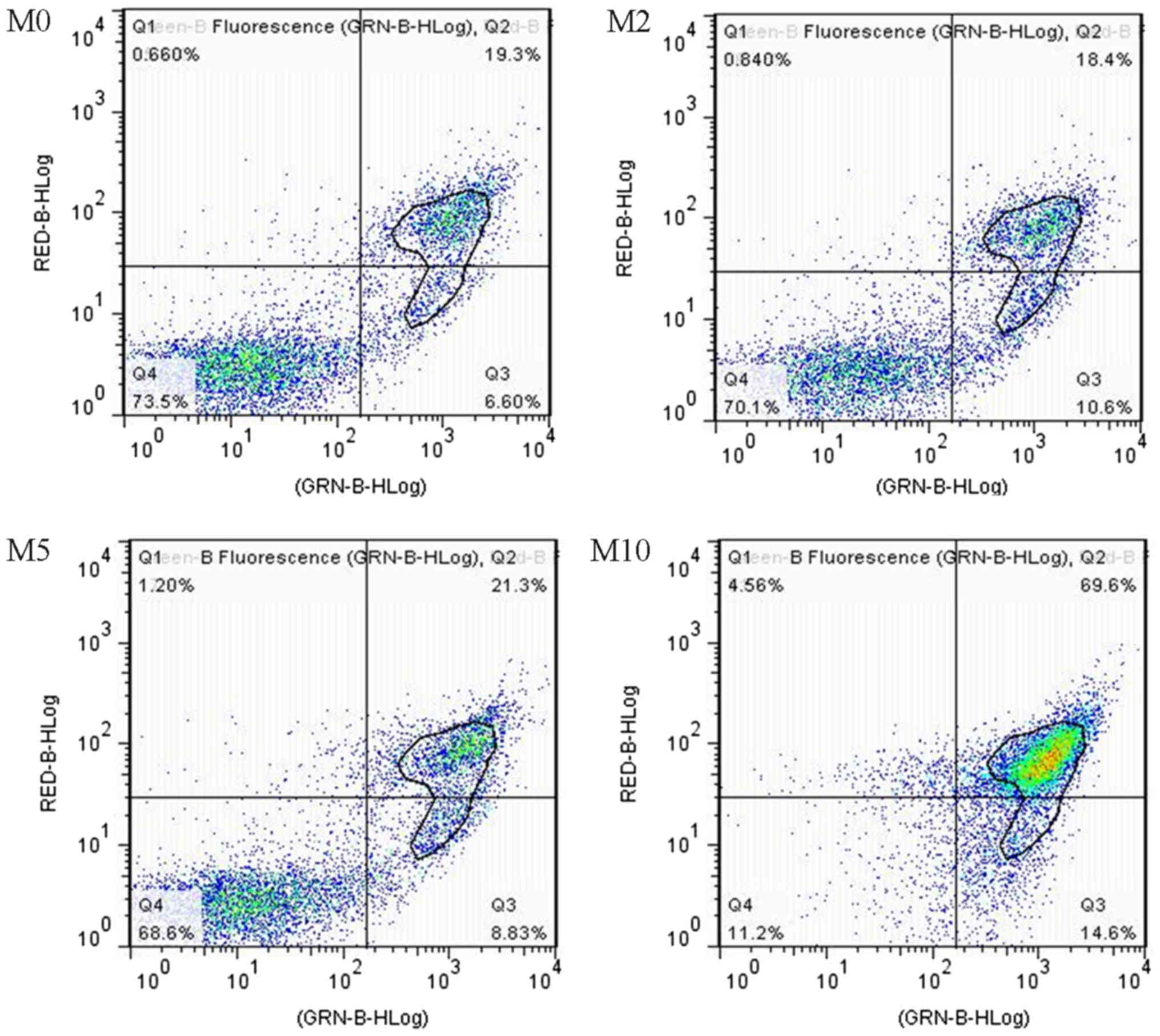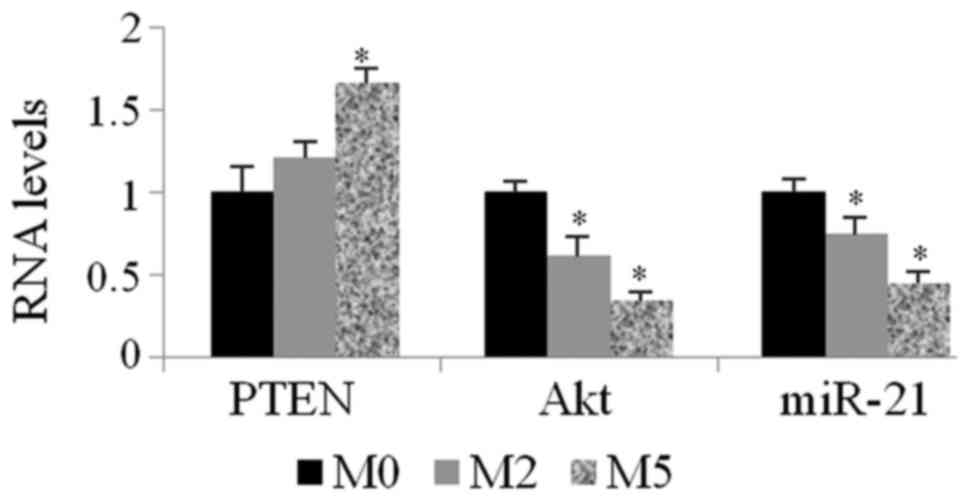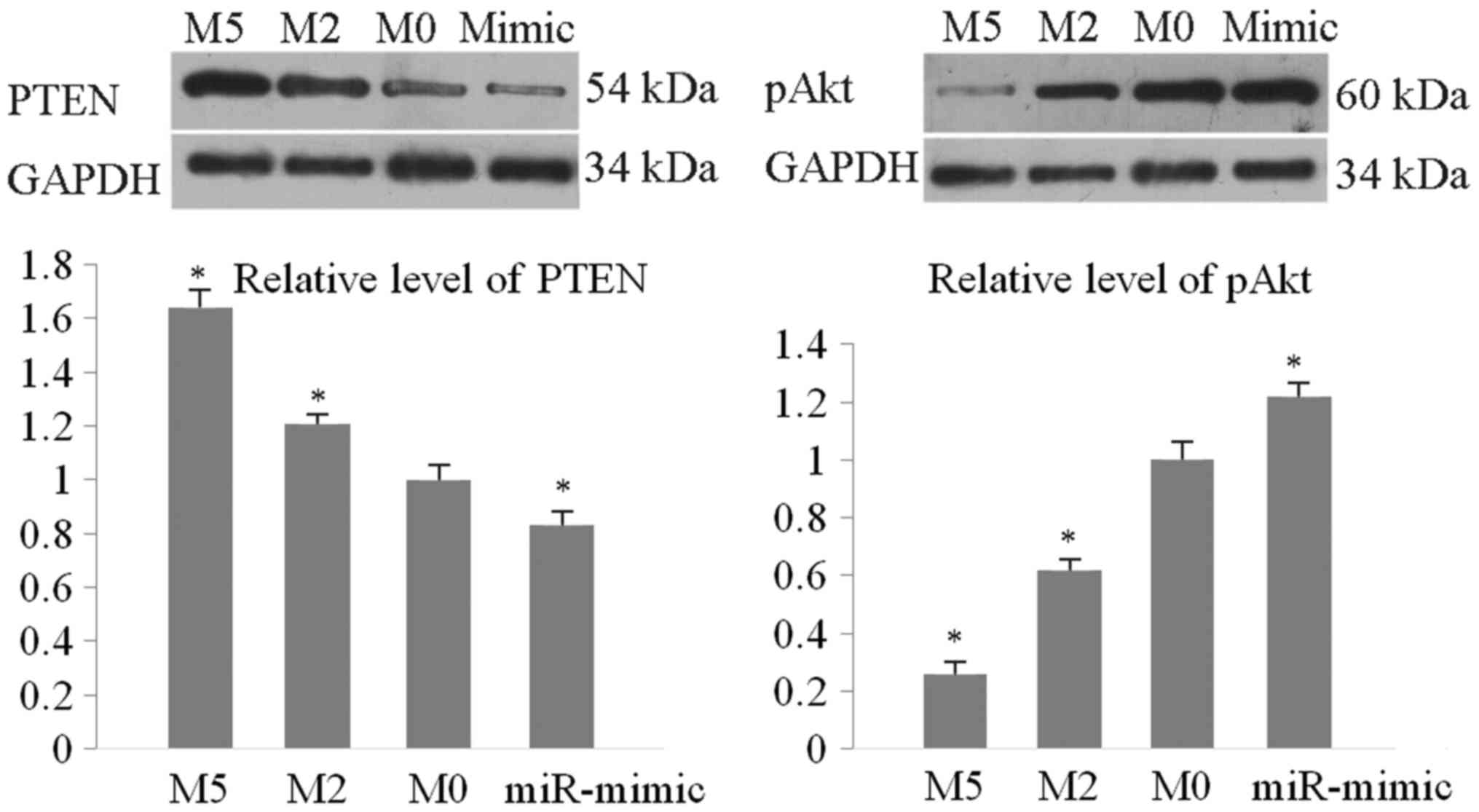Matrine inhibits TPC‑1 human thyroid cancer cells via the miR‑21/PTEN/Akt pathway
- Authors:
- Published online on: June 21, 2018 https://doi.org/10.3892/ol.2018.9006
- Pages: 2965-2970
-
Copyright: © Zhao et al. This is an open access article distributed under the terms of Creative Commons Attribution License.
Abstract
Introduction
Thyroid cancer is the most widespread endocrine malignancy. Papillary thyroid cancer (PTC) is the most common and accounts for approximately 80–90% of human thyroid cancers (1–4). Study of the treatment and pathogenesis of thyroid cancer aids in increasing the rate of early diagnosis of thyroid cancer and the development of novel therapies, improving the quality of life and prognosis, and reducing the mortality of patients with thyroid cancer.
The dysfunction of microRNA (miRNA/miR) has an important association with human PTC (5–9). Transfection of miR-21 into TPC-1 human PTC cells resulted in an increased proliferation and a decreased apoptosis (8). The plasma exosome miR-21 expression pattern in patients with PTC and follicular thyroid cancer (FTC) is distinct from benign tumors (9). miR-21 acts by targeting the tumor suppressor gene phosphatase and tensin homolog (PTEN), which suppresses the tumor by dephosphorylating RAC-α serine/threonine-protein kinase (Akt) (10–13).
The Chinese traditional medicine matrine exhibits extensive anti-tumor activities through multiple mechanisms including pro-apoptotic action, cell cycle arrest, growth inhibition, alteration of miRNA expression, upregulation of PTEN and suppression of Akt (14–22). Li et al (23), reported that the natural medicine matrine may affect miRNA-21 to inhibit MCF-7 breast cancer growth. This result expands the understanding of the antitumor activities of natural medicines.
Considering the extensive anti-tumor activity of matrine and the miR-21 expression pattern in human PTC, the miR-21-regulated antitumor effect of matrine may also exist in PTC. Therefore, the present study was designed to determine the effect of matrine on miR-21 and its target PTEN/Akt pathway in TPC-1 human PTC cells. Proliferation, cell cycle and apoptosis levels were tested. The present study was designed to identify alternative therapeutic methods for treatment of thyroid cancer and provide a foundation for further research on the treatment of thyroid cancer using matrine.
Materials and methods
Cell line and drug treatment
Matrine (C15H24N2O; MW 248.36; CAS:519-02-8; purity >98%) was purchased from Meryer Chemical Company (Shanghai, China). TPC-1 human thyroid cancer cells were donated by CIAC of CAS (Changchun, Jilin, China). Cells were cultured in Dulbecco's modified Eagle's medium (Gibco; Thermo Fisher Scientific, Inc., Waltham, MA, USA) supplemented with 10% fetal bovine serum (Sijiqing Inc., Hangzhou, Zhejiang, China) at 37°C in a 5% CO2 incubator.
MTT assay
TPC-1 cells were seeded in 96-well plates at a density of 105/ml (0.2 ml in each well) for 12 h. Cells were exposed to matrine at a final concentration of 0 (M0, control), 1, 2, 5, 10, 20 mg/ml for 24, 48 and 72 h. Methyl thiazolyl tetrazolium (MTT; Sigma-Aldrich; Merck KGaA, Darmstadt, Germany) at a final concentration of 0.5 mg/ml was incubated in each well for another 4 h. The formazan crystals were dissolved in 150 µl dimethyl sulfoxide and the absorbance was measured at a wavelength of 490 nm by a Multiskan FC microplate reader (Thermo Fisher Scientific, Inc.). All experiments were repeated three times. The percentage growth inhibition vs. the M0 control cells was calculated.
Flow cytometry
For apoptosis analysis, TPC-1 cells in the log phase were collected following treatment with matrine at 0 (control), 2, 5 and 10 mg/ml for 48 h, fixed with 70% ethanol and washed twice with cold PBS. The cells were resuspended in 500 µl binding buffer at a concentration of 106/ml, mixed with 10 µl Annexin V (Bioworld Technology Inc., Jiangsu, China) for 15 min in the dark at room temperature and incubated with 5 µl propidium iodide (PI; Bioworld Technology Inc.) for 10 min in the dark. The cells were analyzed using a FACSCalibur flow cytometer with the CellQuest 3.0 sampling software (BD Biosciences, Franklin Lakes, NJ, USA). The apoptosis rate was determined using the FlowJo software (BD Biosciences).
For cell cycle analysis, TPC-1 cells were cultured in the serum-free medium for 12 h for starvation. TPC-1 cells were treated with matrine at 0 (M0, control), 2, 5 and 10 mg/ml for 48 h. Then, 5×105 cells in each group were fixed with 70% ethanol, washed with cold PBS and incubated with RNase and PI (Bioworld Technology Inc.) for 30 min in the dark. The cells were analyzed by a FACSCalibur flow cytometer using CellQuest 3.0 software (BD Biosciences). The proportion of cells in each phase was determined using the FlowJo software (BD Biosciences). Each experiment was performed three times.
Reverse transcription-quantitative polymerase chain reaction (RT-qPCR)
For detection of miR-21 levels, the experiments were performed using the Ambion mirVanaTM qRT-PCR miRNA Detection kit (Invitrogen; Thermo Fisher Scientific, Inc.) according to the manufacturer's protocol. miR-21 primer sequences for qPCR were 5′-GGGGTAGCTTATCAGACTGATG-3′ (forward) and 5′-TGTCGTGGAGCGGCAATTG-3′ (reverse) (23). To detect PTEN and Akt mRNA levels, total RNA was extracted from TPC-1 cells by TRIzol® Reagent (Invitrogen; Thermo Fisher Scientific, Inc.). The first-strand cDNA was synthesized using FastQuant RT kit (with gDNAase; Invitrogen; Thermo Fisher Scientific, Inc.). Subsequently, double-stranded cDNA was synthesized. Primers for the qPCR were 5′-GCAATATGTTCATAACGATGGCTGTGG-3′ (PTEN forward) and 5′-GAACTGGCAGGTAGAAGGCAACTC-3′ (PTEN reverse); 5′-GCAGGATGTGGACCAACGTGAG-3′ (Akt forward) and 5′-GCAGGCAGCGGATGATGAAGG-3′ (Akt reverse). All primers were synthesized by Sangon Biotech Co., Ltd (Shanghai, China). RT-qPCR was performed on a Roche LightCycler® 96 fluorescence quantification PCR machine (Roche Diagnostics, Basel, Switzerland). The reaction system included 1.5 µl cDNA, 7.5 µl SYBR Green, 0.3 µl of primers and PCR-grade water to the total volume of 15 µl. The PCR thermocycling conditions included a pre-denaturation at 95°C for 30 sec; 40 cycles of 95°C for 15 sec and 60°C for 30 sec for amplification; and a default condition for dissociation (23). The cycle threshold (Ct) values were obtained. Quantitative analyzes of miR-21 or mRNA expression levels were performed following normalization to U6 RNA or GAPDH mRNA (Sangon Biotech Co., Ltd., Shanghai, China). Relative experimental/reference miRNA-21 and mRNA expression was calculated using the following formula: 2−ΔCt(interest-reference). The fold change was calculated using 2−∆∆Ct method.
Transfection of miR-21 mimic and western blotting
TPC-1 cells were transfected with miR-21 mimics using X-treme reagent following the manufacturer's protocol (Roche Diagnostics, Basel, Switzerland). At 48 h after transfection and/or 48 h after the treatment with 0 (M0, control), 2 and 5 mg/ml matrine, the expression of PTEN and p-Akt protein was measured by western blotting. Briefly, TPC-1 cells were washed with cold PBS and lysed in lysis radioimmunoprecipitation assay buffer (Pierce; Thermo Fisher Scientific, Inc.). The concentration of proteins was determined using a bicinchoninic acid Protein Assay kit (Beijing Solarbio Science and Technology Co., Ltd., Beijing, China). The proteins were separated on 10% SDS-PAGE gels. Gels were transblotted to polyvinylidene difluoride membranes (Beyotime Institute of Biotechnology, Jiangsu, China). The membranes were incubated with the mouse anti-PTEN and anti-pAkt monoclonal antibodies (1:1,000 diluted; Cell Signaling Technology, Inc., Danvers, MA, USA) at 4°C overnight, and then with the goat horseradish peroxidase-labeled second antibody (1:1,000 diluted; TransGen Biotech, Beijing, China) at 25°C for 2 h. Chromophore DAB reagent (Beyotime Institute of Biotechnology) was used to develop color. The grayscale ratio of PTEN or Akt to the internal control GAPDH was calculated using the software Image Pro 6.0 (Media Cybernetics, Rockville, MD, USA). The grayscale of test protein bands was normalized to the GAPDH bands.
Statistical analysis
Data are presented as the mean ± standard deviation. SPSS software, v.16.0 (SPSS Inc., Chicago, IL, USA) was used to perform statistical analysis. Student's t-test was used for comparisons between two groups and one-way analysis of variance followed by Dunn's test was used for multiple comparisons. P<0.05 was considered to indicate a statistically significant difference.
Results
Cell viability
MTT assay was performed to determine the growth of thyroid cancer TPC-1 cells following treatment with matrine at 0, 1, 2, 5, 10 and 20 mg/ml for 24, 48 and 72 h, respectively. Matrine inhibited the growth of TPC-1 cells in a concentration- and time-dependent manner (Fig. 1). The half maximal inhibitory concentration (IC50) represents the concentration of a drug that is required for 50% inhibition in vitro and is a measure of the effectiveness of a drug in inhibiting cell growth (24). In the present study, the IC50 of treatment with matrine for 48 h was 3.54 mg/ml.
Apoptosis and cell cycle
Flow cytometry with FITC-A/PI staining was performed to detect apoptosis in TPC-1 thyroid cancer cells exposed to 0, 2, 5 and 10 mg/ml matrine. The total percentage of apoptotic cells is described as the summation of percentages of both early and late apoptotic subpopulations; the annexin V-FITC positive cells (25). The effects of matrine on cell apoptosis are presented in Fig. 2. Matrine at the concentrations of 2, 5 and 10 mg/ml led to 16.1±1.9, 25.9±2.8 and 61.8±5.4% apoptosis, respectively, all elevated compared with 15.1±3.1% in the M0 control group (Table I). Matrine significantly induced TPC-1 cell apoptosis.
Effects of matrine on cell cycle distribution were analyzed by flow cytometry in TPC-1 cells. In the M0 control group, a total of 51.36±2.07% cells were in the G1 phase, 23.37±3.25% in the S phase and 18.49±2.46% in the G2/M phase (Table I). Following treatment with matrine at 10 mg/ml for 48 h, the percentage of cells in the G1 phase increased to 74.49±3.65%, and those in the S phase decreased to 2.42±1.63%. No significant alterations in the percentage of cells in the G2/M phase were observed (Table I). These results demonstrated that matrine induced cell cycle arrest at the G0/G1 phase in thyroid cancer cells.
Expression levels of miR-21, PTEN and Akt
The expression level of miR-21 was determined by qPCR after TPC-1 cells were treated with matrine at 0, 2 and 5 mg/ml (M0, M2 and M5) for 48 h. As shown in Fig. 3, matrine downregulated the expression level of miR-21 in TPC-1 cells (0.75±0.09 for M2/M0 and 0.44±0.13 for M5/M0). PTEN mRNA levels increased by 1.21-fold for M2/M0 and 1.66-fold for M5/M0, respectively. Akt mRNA levels decreased by 0.61-fold for M2/M0 and 0.34-fold for M5/M0.
The protein levels of PTEN and phosphorylated (p)Akt were detected by western blotting. As presented in Fig. 4, PTEN was significantly upregulated by matrine compared with the M0 control (by 1.64-fold for M5/M0 and 1.21-fold for M2/M0). Levels of pAkt were downregulated (0.61 for M2/M0 and 0.24 for M5/M0). The miR-21 mimic markedly reduced the expression level of PTEN protein to 0.83 vs. the M0 blot value and increased the level of pAkt by 1.24-fold vs. M0 blot value. These results demonstrated that matrine regulated the miR-21/PTEN/Akt pathway to induce TPC-1 apoptosis and cell cycle arrest.
Discussion
In the present study, matrine induced apoptosis and G1 cell cycle arrest through downregulating miR-21 to affect the PTEN/Akt signaling in TPC-1 human thyroid cancer cells. Matrine can inhibit cancer cell proliferation by multiple mechanisms in various tumors (14–23). However, the effect of matrine on thyroid cancer has not been previously tested. The present study demonstrated that matrine inhibited growth of TPC-1 cells, suggesting that this medication may be used to treat thyroid cancer. Furthermore, matrine induced apoptosis and cell cycle arrest in TPC-1 cells. These results were consistent with those previously obtained in studies investigating other cancers (14,15,17,14).
Dysfunctional miR-21 regulates a tumor suppressor PTEN to promote cancer cell growth (5,9,11,5). In the present study, miR-21 level in TPC-1 cells treated with matrine was downregulated, and subsequently, expression of its target PTEN was increased at both mRNA and protein levels. Furthermore, miR-21 mimic was transfected into TPC-1 cells and it was determined that overexpression of miR-21 downregulated PTEN protein levels. These results indicated that matrine can regulate miR-21 to prevent PTEN inhibition in TPC-1 thyroid cancer cells. A similar matrine/miR-21/PTEN interaction was observed in MCF-7 breast cancer cells as reported in a previous study (23). PTEN as a tumor suppressor can dephosphorylate Akt to induce apoptosis and cell cycle arrest at the G1 and S phase (10,11,20,10). In the present study, upregulation of PTEN suppressed phosphorylation of Akt to cause apoptosis and cell cycle arrest in the G1 phase in TPC-1 cells.
In addition to the miR-21/PTEN/Akt pathway, matrine may inhibit cancer cells in other ways. Matrine can upregulate proapoptotic proteins including B cell lymphoma (Bcl)-2 associated agonist of cell death, Bcl-2 antagonist/killer 1 and Bcl-2 associated X, apoptosis regulator, and inhibit expression of anti-apoptotic Bcl-2 and Bcl-xl (18,29,30). In addition to the PTEN/Akt signaling, miR-21 serves important roles in cancer growth, proliferation, migration and metastasis by targeting programmed cell death 4 and Sprouty RTK signaling antagonist 1, or by upregulating Bcl-2 indirectly (10,13,31). Overexpression of PTEN upregulates the p21/WAF1/CIP1 and p27/KIP1 pathways by dephosphorylating Akt to increase cell apoptosis and/or induce G1 phase arrest (17,23). These issues should be further investigated in thyroid cancer cells.
In conclusion, the data presented in the present study suggested that the miR-21/PTEN/Akt pathway may be one of the mechanisms for matrine to inhibit TPC-1 thyroid cancer cells. Matrine may be an alternative potential drug for the treatment of thyroid cancer.
Acknowledgements
Not applicable.
Funding
The study was funded by the China Natural Science Foundation (grants no. NSFC81702651) and China Jilin Province Science Technology Project (grant no. 20180101011JC).
Availability of data and materials
All data generated or analyzed during this study are included in this published article.
Authors' contributions
ZL cultured cells and performed flow cytometry, PCR, western blotting and transfection assays. ZX also cultured cells and performed the MTT assay and statistical analysis. CS designed the experiment, revised the manuscript and approved the submission.
Ethics approval and consent to participate
Not applicable.
Patient consent for publication
Not applicable.
Competing interests
The authors declare that they have no competing interests.
References
|
Giusti F, Falchetti A, Franceschelli F, Marini F, Tanini A and Brandi ML: Thyroid cancer: Current molecular perspectives. J Oncol. 2010:3516792010. View Article : Google Scholar : PubMed/NCBI | |
|
Braun J and Hüttelmaier S: Pathogenic mechanisms of deregulated microRNA expression in thyroid carcinomas of follicular origin. Thyroid Res. 4 Suppl 1:S12011. View Article : Google Scholar : PubMed/NCBI | |
|
Leonardi GC, Candido S, Carbone M, Colaianni V, Garozzo SF, Cinà D and Libra M: MicroRNAs and thyroid cancer: Biological and clinical significance (Review). Int J Mol Med. 30:991–999. 2012. View Article : Google Scholar : PubMed/NCBI | |
|
Benvenga S and Koch CA: Molecular pathways associated with aggressiveness of papillary thyroid cancer. Curr Genom. 15:162–170. 2014. View Article : Google Scholar | |
|
Wang T, Xu H, Qi M, Yan S and Tian X: miRNA dysregulation and the risk of metastasis and invasion in papillary thyroid cancer: A systematic review and meta-analysis. Oncotarget. 9:5473–5479. 2017.PubMed/NCBI | |
|
Wang Y, Wei T, Xiong J, Chen P, Wang X, Zhang L, Gao L and Zhu J: Association between genetic polymorphisms in the promoter regions of Let-7 and risk of papillary thyroid carcinoma: A case-control study. Medicine (Baltimore). 94:e18792015. View Article : Google Scholar : PubMed/NCBI | |
|
Perdas E, Stawski R, Nowak D and Zubrzycka M: The role of miRNA in papillary thyroid cancer in the context of miRNA Let-7 family. Int J Mol Sci. 17:E9092016. View Article : Google Scholar : PubMed/NCBI | |
|
Lu X, Jia M, Liu Y, Liu Z, Xu H and Geng Z: The role of microRNA-21 in papillary thyroid cancer cells. Chin J Exp Surg. 29:1981–1982. 2012.(In Chinese with English Abstract). | |
|
Samsonov R, Burdakov V, Shtam T, Radzhabova Z, Vasilyev D, Tsyrlina E, Titov S, Ivanov M, Berstein L, Filatov M, et al: Plasma exosomal miR-21 and miR-181a differentiates follicular from papillary thyroid cancer. Tumour Biol. 37:12011–12021. 2016. View Article : Google Scholar : PubMed/NCBI | |
|
Meng F, Henson R, Wehbe-Janek H, Ghoshal K, Jacob ST and Patel T: Microrna-21 regulates expression of the PTEN tumor suppressor gene in human hepatocellular cancer. Gastroenterology. 133:647–658. 2007. View Article : Google Scholar : PubMed/NCBI | |
|
Qi L, Bart J, Tan LP, Platteel I, Sluis T, Huitema S, Harms G, Fu L, Hollema H and Berg Av: Expression of miR-21 and its targets (PTEN, PDCD4, TM1) in flat epithelial atypia of the breast in relation to ductal carcinoma in situ and invasive carcinoma. BMC Cancer. 9:1632009. View Article : Google Scholar : PubMed/NCBI | |
|
Zhu S, Wu H, Wu F, Nie D, Sheng S and Mo YY: MicroRNA-21 targets tumor suppressor genes in invasion and metastasis. Cell Res. 18:350–359. 2008. View Article : Google Scholar : PubMed/NCBI | |
|
Ma X, Kumar M, Choudhury SN, Buscaglia Becker LE, Barker JR, Kanakamedala K, Liu MF and Li Y: Loss of the miR-21 allele elevates the expression of its target genes and reduces tumorigenesis. Proc Natl Acad Sci USA. 108:10144–10149. 2011. View Article : Google Scholar : PubMed/NCBI | |
|
Liu Y, Xu Y, Ji W, Li X, Sun B, Gao Q and Su C: Anti-tumor activities of matrine and oxymatrine: Literature review. Tumour Biol. 35:5111–5119. 2014. View Article : Google Scholar : PubMed/NCBI | |
|
An Q, Han C, Zhou Y, Li F, Li D, Zhang X, Yu Z, Duan Z and Kan Q: Matrine induces cell cycle arrest and apoptosis with recovery of the expression of miR-126 in the A549 non-small cell lung cancer cell line. Mol Med Rep. 14:4042–4048. 2016. View Article : Google Scholar : PubMed/NCBI | |
|
Wu L, Wang G, Wei J, Huang N, Zhang S, Yang F, Li M, Zhou G and Wang L: Matrine derivative YF-18 inhibits lung cancer cell proliferation and migration through down-regulating Skp2. Oncotarget. 8:11729–11738. 2017.PubMed/NCBI | |
|
Lu Z, Xiao Y, Liu X, Zhang Z, Xiao F and Bi Y: Matrine reduces the proliferation of A549 cells via the p53/p21/PCNA/eIF4E signaling pathway. Mol Med Rep. 15:2415–2422. 2017. View Article : Google Scholar : PubMed/NCBI | |
|
Luo C, Zhu Y, Jiang T, Lu X, Zhang W, Jing Q, Li J, Pang L, Chen K, Qiu F, et al: Matrine induced gastric cancer MKN45 cells apoptosis via increasing pro-apoptotic molecules of Bcl-2 family. Toxicology. 229:245–252. 2007. View Article : Google Scholar : PubMed/NCBI | |
|
Li H, Xie S, Liu X, Wu H, Lin X, Gu J, Wang H and Duan Y: Matrine alters microRNA expression profiles in SGC-7901 human gastric cancer cells. Oncol Rep. 32:2118–2126. 2014. View Article : Google Scholar : PubMed/NCBI | |
|
He M, Jiang L, Li B, Wang G, Wang J and Fu Y: Oxymatrine suppresses the growth and invasion of MG63 cells by up-regulating PTEN and promoting its nuclear translocation. Oncotarget. 8:65100–65110. 2017.PubMed/NCBI | |
|
Peng X, Zhou D, Wang X, Hu Z, Yan Y and Huang J: Matrine suppresses proliferation and invasion of SGC7901 cells through inactivation of PI3K/Akt/uPA pathway. Ann Clin Lab Sci. 46:457–462. 2016.PubMed/NCBI | |
|
Niu H, Zhang Y, Wu B, Zhang Y, Jiang H and He P: Matrine induces the apoptosis of lung cancer cells through downregulation of inhibitor of apoptosis proteins and the Akt signaling pathway. Oncol Rep. 32:1087–1093. 2014. View Article : Google Scholar : PubMed/NCBI | |
|
Li LQ, Li XL, Wang L, Du WJ, Guo R, Liang HH, Liu X, Liang DS, Lu YJ, Shan HL and Jiang HC: Matrine inhibits breast cancer growth via miR-21/PTEN/Akt pathway in MCF-7 cells. Cell Physiol Biochem. 30:631–641. 2012. View Article : Google Scholar : PubMed/NCBI | |
|
Oldham ED, Nunes LM, Varela-Ramirez A, Rankin SE, Knutson BL, Aguilera RJ and Lehmler HJ: Cytotoxic activity of triazole-containing alkyl β-D-glucopyranosides on a human T-cell leukemia cell line. Chem Cent J. 9:32015. View Article : Google Scholar : PubMed/NCBI | |
|
Robles-Escajeda E, Lerma D, Nyakeriga AM, Ross JA, Kirken RA, Aguilera RJ and Varela-Ramirez A: Searching in mother nature for anti-cancer activity: Anti-proliferative and pro-apoptotic effect elicited by green barley on leukemia/lymphoma cells. PLoS One. 8:e735082013. View Article : Google Scholar : PubMed/NCBI | |
|
Jin H, Sun Y, Wang S and Cheng X: Matrine activates PTEN to induce growth inhibition and apoptosis in V600EBRAF harboring melanoma cells. Int J Mol Sci. 14:16040–16057. 2013. View Article : Google Scholar : PubMed/NCBI | |
|
Fragni M, Bonini SA, Bettinsoli P, Bodei S, Generali D, Bottini A, Spano PF, Memo M and Sigala S: The miR-21/PTEN/Akt signaling pathway is involved in the anti-tumoral effects of zoledronic acid in human breast cancer cell lines. Naunyn Schmiedebergs Arch Pharmacol. 389:529–538. 2016. View Article : Google Scholar : PubMed/NCBI | |
|
Lv C, Hao Y and Tu G: MicroRNA-21 promotes proliferation, invasion and suppresses apoptosis in human osteosarcoma line MG63 through PTEN/Akt pathway. Tumour Biol. 37:9333–9342. 2016. View Article : Google Scholar : PubMed/NCBI | |
|
Yu P, Liu Q, Liu K, Yagasaki K, Wu E and Zhang G: Matrine suppresses breast cancer cell proliferation and invasion via VEGF-Akt-NF-kappaB signaling. Cytotechnology. 59:219–229. 2009. View Article : Google Scholar : PubMed/NCBI | |
|
Liang CZ, Zhang JK, Shi Z, Liu B, Shen CQ and Tao HM: Matrine induces caspase-dependent apoptosis in human osteosarcoma cells in vitro and in vivo through the upregulation of Bax and Fas/FasL and downregulation of Bcl-2. Cancer Chemother Pharmacol. 69:317–331. 2012. View Article : Google Scholar : PubMed/NCBI | |
|
Yan LX, Wu QN, Zhang Y, Li YY, Liao DZ, Hou JH, Fu J, Zeng MS, Yun JP, Wu QL, et al: Knockdown of miR-21 in human breast cancer cell lines inhibits proliferation, in vitro migration and in vivo tumor growth. Breast Cancer Res. 13:R22011. View Article : Google Scholar : PubMed/NCBI |













